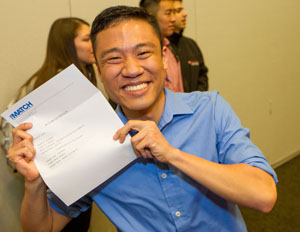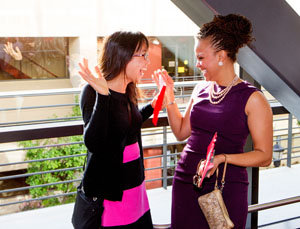March 21, 2014 - By Tracie White

Kira and Erick Westbroek, with the couple's 5-month-old daughter, Wren, on Match Day. Erick Westbroek found out at the event that he will be doing his residency in neurosurgery at Johns Hopkins University, his first choice.
Finally, after years of chasing dreams of becoming a physician — the endless hours of hard work, countless nights of study, years of college and a final interview process that would challenge the nerves of the most hardened Navy SEAL — it all came down to this:
Stephanie Carr held up the sealed red envelope for her family to see, anxiously awaiting instructions to look inside.
"And the Oscar goes to..," whispered her uncle, Ralph Hernandez, with a grin, echoing the often-used metaphor that compares Match Day to the drama of the Academy Awards ceremony. Carr, an MD/MBA graduate, gripped her boyfriend's hand and smiled nervously at the room full of her classmates — each anxiously waiting to open their own envelopes.
Welcome to Match Day, the annual event where thousands of medical students across the United States gather at the same time — 9 a.m. in California — with family, friends, classmates and faculty, to find out where they will spend the next three to seven years of their lives for their hospital residencies.
The matching process is a tradition stretching back to the 1950s, with residency assignments ultimately determined by a nonprofit organization, the National Resident Matching Program. The group uses a computer algorithm to align the choices of the applicants with those of the residency programs.

With boyfriend Michael Woods at her side, Stephanie Carr opens her Match Day envelope to discover that she will be heading to the University of Washington — her first choice — for an internal-medicine residency.
But the process that led up to today's ceremony actually started almost a year ago, beginning with students in their final year of medical school filling out applications in the summer, traveling to cross-country interviews in the fall and then beginning the long waiting process.
"We're really proud of you and all you've accomplished to get here today," said Lloyd Minor, MD, dean of the School of Medicine, who led off the morning's ceremonies at the Li Ka Shing Center for Learning and Knowledge by wishing the class of 2014 much success as they moved on, building their future careers as leaders in medicine.
Charles Prober, MD, senior associate dean for medical education, next took the stage, teasing the class of 81 newly minted physicians with early results of the matching process.
He applauded the graduating students for their combined 415 years of medical school, 450 letters of recommendation, 1,000 interviews (an average of 12 per candidate), with an estimated 400,000 frequent-flier miles to attend those interviews nationwide.
The 81 students matched in 19 different disciplines in a total of 15 different states. California topped that list with 17 percent of all the graduating students.

Kevin Chi displays the letter informing him that he has matched in pediatrics at Stanford — his first choice.
With the clock ticking toward the 9 a.m. deadline, Prober then began to direct students to the various rooms where their advisers would pass out the envelopes.
"You will receive a cardinal-red envelope," he said. "You will open it and the rest of your life will be decided." The well-dressed crowd tittered nervously, then scattered off.
Carr high-fived a fellow student as she shuffled out with her family in tow — her mother (a dentist who instilled a love of medicine in her daughter), her grandmother, her boyfriend and her uncle. At just past 9 a.m., the students were given the go-ahead to open their envelopes all at the same time.
"Am I going to U-dub?" Carr asked her family, squinting at the letter, referring to the University of Washington, her first choice for a residency in internal medicine.
"Yes!" her boyfriend, Michael Woods said, reading the words, "Congratulations you have matched!"
"Yes!" Carr said, jumping up and pumping her fists.
Tears, yells, hugs and screams filled the building as students opened their letters and read their futures.

Medical students Jocelyn Chin and Miquell Miller compare results of their residency matches.
Seventy percent of the 81 students matched with their first choice and 90 percent with one of their top three choices. At the top of the list for medical specialties was internal medicine, with 19 students. Pediatrics came in second, with nine students."It was a long, painful process," said Kevin Chi, his shaking hands holding the letter that told him he had matched in pediatrics at Stanford, his first choice. He hugged fellow student Tania Rezai, who had matched to a family medicine residency in Santa Rosa.
"But this made it all worth it," Chi said, holding up the letter. "To be in a place we want to be, with people we want to be with, doing the things we want to do."
As the excitement settled down and the crowd moved out into the lobby where champagne awaited, Kira Westbroek took her 5-month-old baby, Wren, outside and sat on the cement stairs in the sun. The new mother had just found out she was moving to Baltimore. Her husband, Erick, had matched in neurosurgery at Johns Hopkins, and the family was thrilled.
"Wren was born in October, right in the middle of the interview process," her mother said, smiling up at her husband as he joined her on the stairs. With a little expert juggling of the interview scheduling process, Erick was able to be present at the birth of their baby. And, as he just found out today, still managed to match with his first choice.
"Hopkins!" he announced to a questioning friend coming up the stairs.
"Awesome, dude!" the friend answered back, and the two hugged.
About Stanford Medicine
Stanford Medicine is an integrated academic health system comprising the Stanford School of Medicine and adult and pediatric health care delivery systems. Together, they harness the full potential of biomedicine through collaborative research, education and clinical care for patients. For more information, please visit med.stanford.edu.